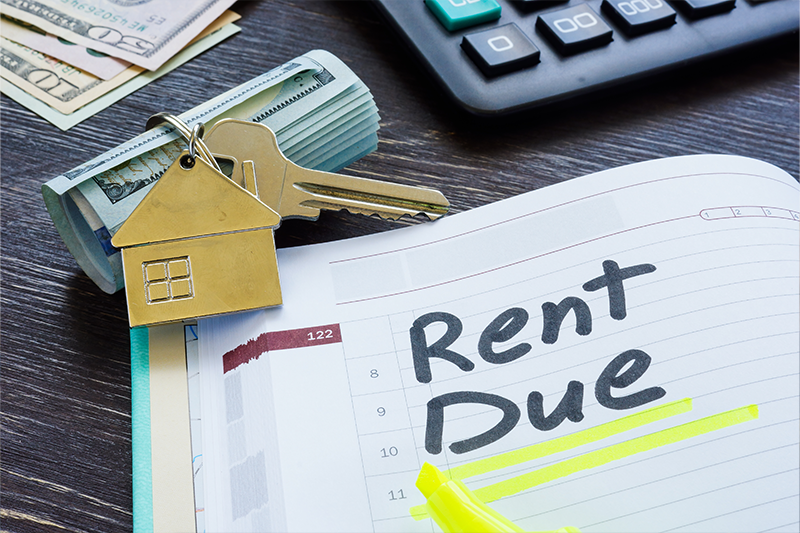Can You Pay Rent with a Credit Card and How

Paying rent with a credit card may sound unusual, but you might be surprised at how common it is – especially as consumers look for flexibility, convenience and the chance to earn rewards. Whether you’re trying to cover rent before your paycheck hits or want to meet the minimum spend for a credit card bonus, it’s worth asking yourself the question: Can you pay rent with a credit card, and how should you go about it?
The answer depends on several factors – like your landlord, the services available to you, and your overall financial strategy. And while rent is typically your largest monthly expense, using a credit card to pay it comes with both advantages and risks.
Let’s take a look at what you need to know before you decide to pay your rent with plastic.
Understand Landlord Policies and Acceptance
Before you try to pay rent with a credit card, check your lease agreement or reach out to your landlord or property manager. Not all property owners accept credit card payments, and those who do may add a surcharge to cover merchant processing fees – the costs businesses incur in order to accept credit cards.
Some landlords or rental companies partner with online platforms to allow electronic payments, including by credit or debit card. Others may only accept traditional forms of payment, like checks or direct deposit from your bank account. It's also possible that your landlord may allow a one-time exception if you're in a financial bind and can’t make your monthly rent on time.
If your landlord does accept credit cards, confirm with them how they'll process your payment, when it will post, and whether you’ll pay a transaction fee. Make sure you understand their expectations around on time payments, since delayed processing could mean you have to pay late fees.

Explore Third-Party Services for Rent Payments
If your landlord doesn’t directly accept credit cards, some third-party services offer a workaround. Platforms like Plastiq, PlacePay, RentTrack and Story by J.P. Morgan let you to use a credit card to cover rent, even if your landlord doesn’t offer that option. These are independent third-party services not affiliated with or endorsed by Access Finance. Availability and fees may vary by provider. Please review each provider’s terms and conditions carefully before using their services.
Here's how it works: You pay the third-party platform with your credit card, and they send money to your landlord, either by a physical check or an electronic payment. These services are convenient and don't usually need any action on the landlord’s part – even though some do ask landlords to create accounts or accept direct deposit.
But – you should be prepared to pay a transaction fee, usually between 2.5% and 3%. For example, if your rent is $2,000 and the service charges are 2.99%, you’ll pay an extra $59.80 each month – an amount that can quickly add up and reduce the value of any credit card rewards you may be earning by paying your rent with a credit card.
While these fees might be worth it to cover rent during a cash flow crunch or to meet minimum spending requirements on a new card, it's important to run the numbers first and make an informed choic
Use Online Rent Payment Platforms
Some larger property management companies and real estate firms use integrated online bill payment services like RentPayment, ClickPay or Buildium. These platforms can allow tenants to pay rent through several different payment methods, including credit or debit card, ACH transfer or checking account.
If your landlord is enrolled in one of these systems, you may be able to set up recurring payments, get payment reminders and even track receipts, all of which make it easier to stay organized and avoid late fees.
In some cases, you can also use these platforms to split rent with roommates, automate payments or link multiple bank accounts. However, keep an eye out for merchant processing fees for credit card use, which could still apply even if the landlord is part of the platform.
If you’re using a credit card that’s designed for simple, everyday purchases – like the Juzt Credit Card, which is a digital-first option that doesn’t require a deposit – you might find it fits well with these rent payment platforms.
Set Up Direct Payments with Your Landlord
Some landlords are open to accepting credit card payments directly, especially if you're willing to cover expenses like associated fees. If your landlord prefers person-to-person apps like Venmo, Zelle or PayPal, you might be able to use your credit card through those platforms, but they often charge around 2.9% to 3% per transaction.
When using these payment platforms, make sure you understand how your payment is classified. Some platforms may treat rent costs as a business transaction, triggering high processing fees, while others might restrict credit card usage altogether unless your landlord has a business account.
To avoid confusion or disputes, it's a smart idea to document all transactions and confirm that payments are posting to the landlord’s account on time.

Assess Convenience Fees and Costs
The reality is that using a credit card to pay rent can be expensive. Many services charge a merchant processing fee or transaction fee that ranges from 2.5% to 3% of your rent amount. On a $1,200 monthly rent, that’s an additional $30 to $36 every month – or more than $400 each year.
In most cases, rewards credit cards offer 1% to 2% back on purchases, meaning your cash back or miles might not be enough to offset the fees you’re paying. But – paying rent with a credit card could make sense if you’re working toward welcome bonus points or trying to earn rewards for other purchases. It all depends on the credit card you have.
Still, it’s important to ask yourself: is it worth paying $30 a month in fees just to earn $15 in cash back?
It might not make sense to pay your rent with a credit card. If you are experiencing financial hardship, carefully consider all of your options, including discussing payment arrangements with your landlord or seeking local rental assistance programs. Using a credit card for rent may increase your debt if not repaid in full, and you may incur interest and fees.
In these situations, Juzt Digital Credit Card could be a great fit. It’s unsecured – so you don’t need to put down a deposit – and it reports to Equifax, helping you build a positive payment history. You can apply in minutes and use your card right away upon approval. With starting credit limits between $400 and $1,000, the Juzt Card is manageable, and it’s a solid way to show lenders you can handle some monthly payments. Juzt Credit Card is issued by tbom®, Perryville, MO. Standard credit approval required. Rates, fees, and terms are subject to change. See the Juzt Credit Card Terms and Conditions for complete information, including APRs, fees, and repayment obligations. Rewards may not offset transaction or cash advance fees.
Ensure Security and Privacy in Transactions
Security is critical when dealing with credit card transactions, especially for something large and recurring like rent payments. Make sure to use only reputable online services or platforms that offer encryption, fraud protection and clear documentation.
A major risk of paying rent with a credit card is increasing your credit utilization ratio: the percentage of available credit you're using at any given time. Experts recommend keeping your ratio under 30% to avoid negatively impacting your credit scores, so it’s important to stay on top of how much credit you’re using.
For example – let’s say your rent is $1,800 and your credit limit is $5,000. That’s a 36% utilization rate, which could lower your score until you pay off the credit card balance. And if you carry a balance into the next billing cycle, you’ll collect interest charges that can quickly compound.
To avoid this financial burden, you can ask your card issuer for a higher limit or consider making mid-month payments to keep your balance lower.
Communicate with Your Landlord About Payment Method
If your landlord doesn’t already accept rent payments by credit card, it doesn’t hurt to ask if they’d be willing to start. With the rise of online service platforms, more property owners are open to digital payments.
When you approach your landlord, explain why you’re interested in this payment option (e.g., travel plans, financial flexibility, earning rewards) and offer to use a reputable third-party processor. Some landlords may actually appreciate the ease of automated payments and recordkeeping.
You may even discover that your landlord has been considering an update to their system but didn’t know tenants were interested.
Explore Alternatives if Credit Card Payment Isn’t Accepted
If paying your rent with a credit card isn’t an option, below is a summary of other alternatives you can consider:
Consider balance transfer cards, which offer 0% introductory APRs on transferred balances. Moving debt from a high-interest card can free up money for rent.
Look into cash advances, which allow you to withdraw money from your credit line. But they often come with high fees and interest charges that hit immediately, so this may not be as attractive as other options.
Ask your employer for an advance on your paycheck if you’re short on cash until payday arrives.
Reach out to rental assistance programs in your area if you're facing financial hardship. Many nonprofits and local governments offer temporary aid.
Speak to your landlord about a flexible payment plan to avoid late fees or eviction. Being upfront about your situation may lead to a short-term solution.
Whatever option you choose, make sure your financial decisions align with your long-term goals and try to avoid racking up unsustainable debt.
And if your landlord won’t take credit cards, the Juzt Credit Card can still come in handy for other bills that go hand-in-hand with rent – like utilities, internet or even renter’s insurance. And by keeping those payments on one card and paying it off in full each month, you’ll build credit without adding unnecessary fees. So, can you pay rent with a credit card? Yes, in many cases you can. Whether directly through your landlord or through a third party service, using your card to cover rent offers convenience, potential rewards and financial breathing room when you need it.
But there are caveats: like the potential fees involved, possible damage to your credit scores, and the temptation to borrow money you can’t repay. If you’re considering this route, look at your overall budget, interest rates, and your ability to pay your credit card bill in full each month.
Like any tool, a credit card is most powerful in the hands of a responsible user. Using the strategies outlined here, you can make a sound and informed decision about whether paying your rent with a credit card is the right choice for you.
This article is for informational purposes only and does not constitute financial or legal advice. Payment acceptance policies, fees, and credit terms vary by landlord, third-party service, and card issuer. Please review your lease, service agreements, and cardholder terms carefully before deciding whether to use a credit card for rent payments.
Frequently asked questions
Table of contents
-
Understand Landlord Policies and Acceptance
-
Explore Third-Party Services for Rent Payments
-
Use Online Rent Payment Platforms
-
Set Up Direct Payments with Your Landlord
-
Assess Convenience Fees and Costs
-
Ensure Security and Privacy in Transactions
-
Communicate with Your Landlord About Payment Method
-
Explore Alternatives if Credit Card Payment Isn’t Accepted